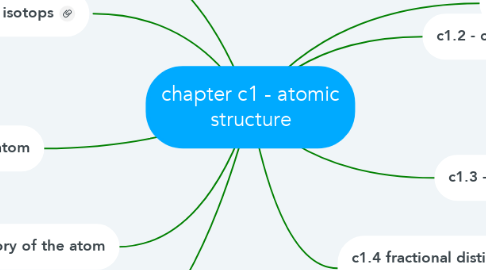chapter c1 - atomic structure
by Aidah Parvez

1. c1.6 - structure of the atom
1.1. - protons have a mass and charge of +1 - neutrons have a mass of 1 and no charge - electrongs have a charge of -1 and a mass that is negligible
1.2. - the atomic numbr is the number of protons in each atom of an element
1.3. - the mass number is the number of protons and neutrons in the nucleus of an atom
2. c1.7 - ions, atoms and isotops
2.1. - an ion is a charged atom or group of charged atoms and occur when an atom loses or gains an electron
2.2. - isotopes are atoms of the same element with different numbers of neutrons
3. c1.5 - history of the atom
3.1. - Thompson developed the 'plum pudding' model (a sphere of positive charge with negative electrons embedded between)
3.2. - Geiger and Mardsen did the gold foil experiment, Rutherford suggested that positive charge was concentrated at a tiny spot in the centre of the atom and that electrong orbitted around this nucleus (which conains nery dense positively charged protons)
3.3. - Bohr revised the atomic model and suggested lectrons orbitted the nuclear at set distances and in certain fixed energy levels (shells)
3.4. - Chadwick did an experiment that explained the existence of neutrons (subatomic particals with no charge yet still holding mass)
4. c1.8 - electronic structures
4.1. - electrons are arranged around the nucleus in shells
4.2. - the first shell (nearest to the nucleus) can hold up to 2 electrons
4.3. - the next shells can hold up to 8
4.4. - the number of electrons in the outermost shell of an element's atom determines the way in which that element reacts
5. \
6. c1.1 - atoms
6.1. - all substances are made of atoms
6.2. - a group of 1 type of atom is called an element
6.3. - symbols in the periodic table represent elements
6.4. - elements in the table are arranged in column called groups and consist of elements with similar chemical properties
7. c1.2 - chemical euqations
7.1. - chemical equations show the ractants and the prodcts in a reaction
7.2. - symbol equations can help you see how much of each substance is involved in a reaction
7.3. - the total mass of the products formed in a reaction is euqal to the total mass of the reactants (the law of conservation of mass)
8. c1.3 - separating mixtures
8.1. - a mixture is made up of two or more substances (elements or compounds) that are not chemically combined together
8.2. - compounds has a fixed composition, chemical reactions must be used to spearate the elements and there are chemical bonds between the different elements of the compound
8.3. - separation techniques include: filtration, cystallisation, distillation and chromatography
8.4. - filtration is used to separate substances that are insoluble in a particular solvent from those that are soluble in the solvent
8.5. - crystallisation separates a soluble solid from a solvent through boiling it then letting it cool to form crystals
8.6. - distillation separates a mixture of liquids (of which have different boiling points) and heating the mixture and collecting the one with the lowest boiling point first (through a series of condensation) any solids remain in the heating flask
9. c1.4 fractional distillation and paper chromatography
9.1. - fractional distillation is distillation however using a fractionating column (a tall glass column fitted vertically on top of the flask being heated) - vapours pass over and between glass beads in the column before reaching the condenser - the temperature in the colum is highest at the bottem and gets lower as vapours rise up - substances with higher boiling points condense more readily on the cooler glass beads nearer the bottom of the column and will drip back down into the flask beneath again - substances with the lower boiling point will continue rising and pass over into the condenser where it is cool enough to turn back into the liquid state and be collected
9.2. - paper chromatography works because some compounds in a mixture dissolve better than others in the solvent chosen - a capillary tube is used to dab a spot of the solution on a pencil line near the bottom of a sheet of absorben chromatography paper - the paper is then placed standing at the bottom of a beaker with a bit of solvent in it - the solvent soaks up the paper and carries the soluble substance up the paper with it


